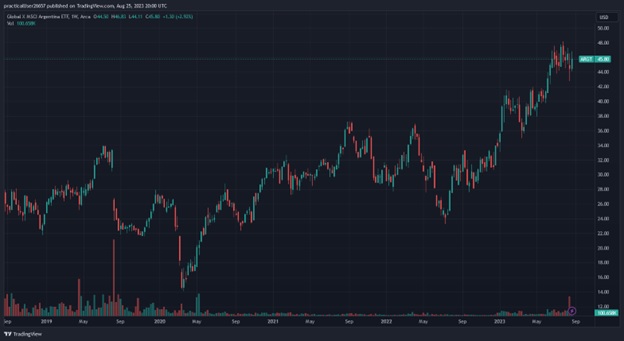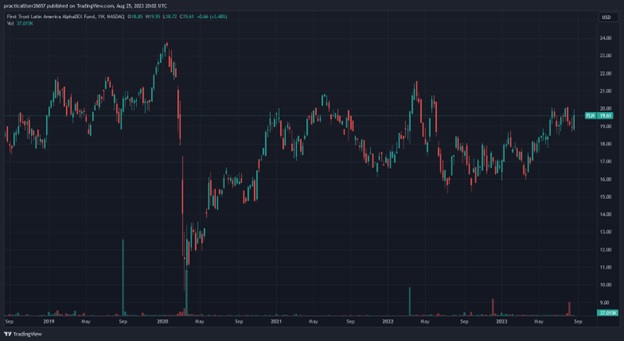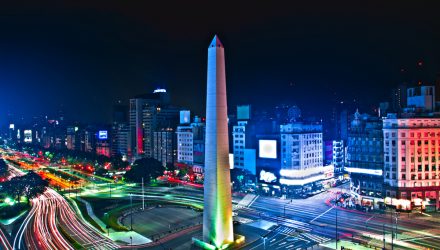Argentina’s official election isn’t until October. However, Libertarian economist Javier Milei’s big upset in the August primary suggests the South American country could soon have a new president. And the unexpected turn of events could set the scene for a rebound in Argentina stocks.
Milei is a political outsider no one thought had any chance at winning. The upset suggests Argentines are fed up with the status quo. After all, it has resulted in persistent inflation that surpassed 100% this year. Meanwhile, the country’s cost-of-living crisis has tipped about 40% of Argentines into poverty.
Is It the Right Time to Buy Argentina Stocks?
Milei has not yet been officially elected president of Argentina. However, hopes that he will indeed capture the October election are lighting a fire under some Argentine stocks. Despite its economic turmoil, Argentina is the third-largest economy in Latin America. It’s easy to see why investors are drawn to the potential that may exist in its markets.
Over the last year, Argentina’s flagship stock index, the S&P MERVAL, has more than tripled in value, with two-thirds of that gain coming in 2023 year to date. So far in August, the MERVAL Index, which tracks the largest domestic stocks with the highest liquidity on the Bolsas y Mercados Argentinos Exchange, is up 34%.
So does this mean the Argentina stock market is finally a buy? Some investors are certainly considering it — and some have clearly already decided. In fact, some foreign hedge funds had already piled into Argentine stocks earlier in the summer, months before the primary election with its surprise outcome.
Buenos Aires stock exchange chief Adelmo Gabbi said on Thursday that Argentina stocks offer a “safeguard of value” to investors. He also said investors who get into the Argentine stock market now are buying in at “very low prices.”
However, so far investors are largely sticking to U.S.-listed Argentina stocks rather than buying them directly on Argentina’s stock market. The trend suggests investors are willing to take a small gamble on the South American nation without committing fully to its financial markets, or at least not quite yet.
See More: Chinese Miner Invests $1.7 Billion in Argentina Lithium Projects
Potential Strategies for Argentina Stocks
Nonetheless, there’s no denying that if Milei does manage to win the Argentine election, many of Argentina’s biggest companies should benefit significantly in the event of a switch to more market-friendly policies.
For now, it’s important for investors to realize that the August vote in Argentina was only the primary, so the actual election could bring a different result. Thus, investors are faced with two broad potential courses of action.
The first is to dive headlong into Argentina’s stock market in hopes of winning big on stock prices. After all, they could explode if Milei pulls out a win in the October election. The other is to take a wait-and-see approach to Argentine stocks. That would be a more conservative play. However, it may cause investors to miss a significant amount of the potential upside if he wins the election.
However, any discussion about potential investment strategies for Argentina’s stock market is not complete without a discussion about exchange-traded funds, which may offer diversified exposure to the nation’s stock market.
The Largest U.S.-listed Argentina ETF: ARGT
Despite the robust rally in the S&P MERVAL Index immediately following the primary upset, the largest U.S.-listed ETF focused on the Argentine stock market initially tumbled by the largest percentage since 2020. The Global X MSCI Argentina ETF (ARGT), which has about $72 million in assets, slumped by as much as 8% initially before rebounding to trim its losses to about 1%.

However, the ETF, which holds only 24 positions, was up 2% for the five days ended Aug. 25 and down less than 4% for the last 30 days as of the end of last week. ARGT’s top holdings include U.S.-listed shares of the well-known e-commerce giant Mercado Libre. The company has its headquarters in Buenos Aires and accounts for 20% of the ETF’s portfolio.
Other top holdings include McDonald’s franchise owner Arcos Dorados, domestically owned private bank Banco Macro, agro-industrial giant Adecoagro, Argentine energy firm Pampa Energia, and leading Latin American retailer Cencosud.
Argentina as Part of Emerging Markets ETFs
Aside from targeting Argentina specifically, an investor could buy an ETF that invests in emerging markets, including Argentina. Given that Argentina is Latin America’s third-largest economy, emerging-markets ETFs focused on Latin America may offer some solid options.
One company that appears often in many emerging-markets and Latin-American ETFs is Mercado Libre, which accounts for a significant chunk of Argentina’s GDP. However, you may have to dig deeper to find ETFs with more Argentine stocks. You may also need to accept stocks that may not be based in Argentina but have exposure there.
For example, Cencosud isn’t headquartered in Argentina, but it does have operations there and in four other Latin American countries. Thus, some options may include ETFs like the First Trust Latin America AlphaDEX Fund (FLN), which lists Cencosud among its top holdings.

Unfortunately, Argentina’s economic hardships makes it challenging to find ETFs with sizable exposure to Argentina aside from ARGT. The only other ETF with significant exposure to Argentina was the iShares MSCI Argentina and Global Exposure ETF (AGT), but it was shut down in August 2022.
Of course, investors should always do their due diligence before investing, whether it’s in a tricky market like Argentina or anywhere else.
Charts via TradingView
For more news, information, and analysis, visit VettaFi | ETF Trends.
